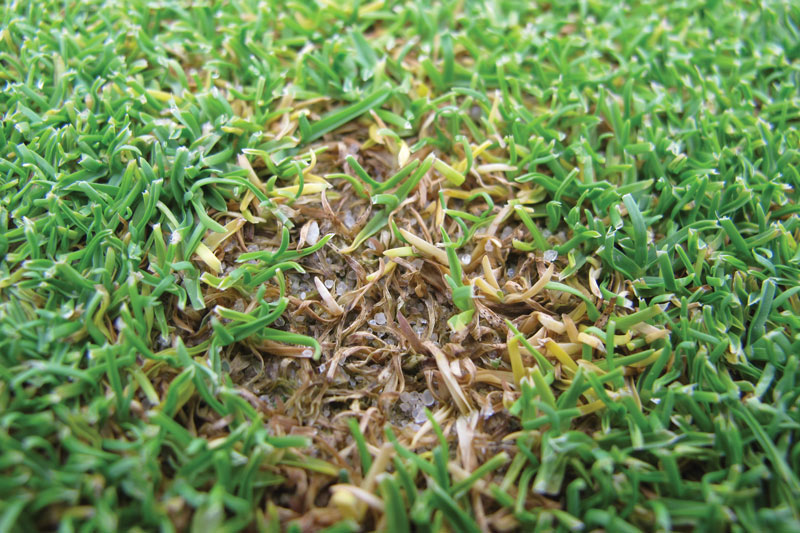
Symptoms of anthracnose disease of annual bluegrass include yellow leaf spots with small, black, spore-bearing structures called acervuli. In this photo, some of the leaves have turned brown and are sprinkled with the spore-bearing structures. Photo by James Hempfling
Editor’s note: This research was funded in part by a grant to GCSAA from the Environmental Institute for Golf.
Anthracnose is a destructive disease (caused by the fungus Colletotrichum cereale) that occurs on cool-season turf throughout the world (6,29). During the mid-1990s, outbreaks of anthracnose on annual bluegrass (Poa annua) putting green turf increased in frequency and intensity (7,8,20,21), but over the past 15 years, scientists within the NE-1025 and NE-1046 multistate turf research project have made tremendous progress in developing a better understanding of what constitutes best management practices (BMPs) for anthracnose disease on golf course putting greens (22,23). This report updates our findings on BMPs since we last summarized research on this subject in 2012 (22).
Research has repeatedly demonstrated that anthracnose can be very destructive on weakened turf. Plant nutrient deficiencies, ultra-low mowing, and excessively wet or dry irrigation programs are all critical stress factors that greatly increase the risk for serious damage from anthracnose. As a result, BMPs include practices that address these plant health factors.
Although it is true that anthracnose is a stress-related disease, research has demonstrated that wounding caused by practices such as topdressing, verticutting, coring and solid tining does not intensify anthracnose (9,18,25). Thus, superintendents should focus on implementing well-designed topdressing and cultivation programs that strengthen a healthy turf, and should dismiss any concerns that such practices might intensify anthracnose through wounding.
Plant nutrition
The severity of anthracnose is strongly linked to deficiencies in nitrogen and potassium that affect the health of annual bluegrass. Soil pH also has been shown to affect the intensity of this disease.
Nitrogen
Numerous studies have shown that it is important for superintendents to evaluate whether nitrogen fertility is limiting turf vigor when attempting to manage anthracnose.
Light-rate, frequent fertilization (spoon-feeding) of nitrogen during the summer is highly effective at suppressing anthracnose (14). In research trials where anthracnose was not treated with fungicides, fertilization at 0.1 to 0.2 pound of nitrogen/1,000 square feet (0.49-0.98 gram/square meter) per week greatly reduced disease severity (14, 27). In fact, in some years, 0.1 pound of nitrogen/1,000 square feet/week along with the correct combination of other cultural practices (for example, mowing height and sand topdressing) sufficiently suppressed the disease to the point that some might consider fungicide control unnecessary (12).
Although some superintendents might consider 0.1 pound of nitrogen/1,000 square feet a rather high rate, it is not excessive for managing anthracnose. Under high disease pressure, up to 0.2 pound of nitrogen/1,000 square feet/week may be required to provide optimal disease suppression. Anthracnose did not intensify until researchers applied extremely high rates of nitrogen (≥0.3 pound/1,000 square feet; 1.46 grams/square meter per week) on putting greens (27).
The studies cited here have identified a range of nitrogen rates and frequencies recommended for managing this disease. However, differences in length of growing season, soils and weather can also influence nitrogen fertility requirements. The key is to maintain sufficient nitrogen in the plant (~3.35% nitrogen in leaf tissue) through frequent, light-rate applications of soluble nitrogen to optimize anthracnose suppression (13). Tissue testing of clippings offers superintendents a strategy, other than calendar-based fertilization, to fine-tune spoon-feeding applications to optimize anthracnose control, independent of site and seasonal differences.
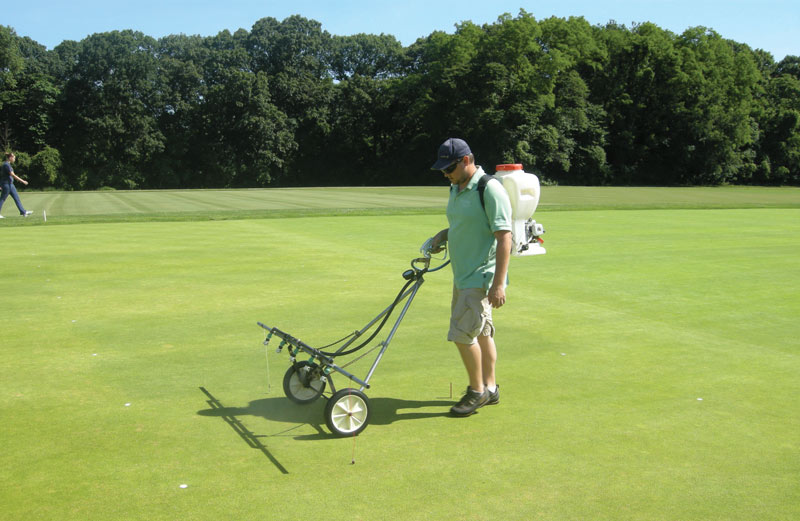
Nitrogen fertilization treatments were applied to research plots for the nitrogen rate study. Photo by James Murphy
Superintendents need to consider factors other than anthracnose that affect the need for nitrogen, including playability, intensity of traffic, and vigor of the turf, as well as management intensity (mowing, pest pressure, cultivation, irrigation, etc.).
Frequent plant growth regulator applications are an effective tactic for maintaining green speed and for eliminating excess vertical shoot growth caused by light-rate, frequent nitrogen fertilization. Studies evaluating trinexapac-ethyl (Primo MAXX, Syngenta), mefluidide (Embark, PBI-Gordon) and ethephon (Proxy, Bayer) alone or in combination have shown that these products will not intensify anthracnose severity (14,16,17). And there is evidence that these plant growth regulators may, in some instances, subtly reduce anthracnose so that seedheads are suppressed and plant vigor is enhanced (4,14,16,17). Although small and inconsistent reductions in anthracnose were observed when trinexapac-ethyl was applied every 14 days, applications based on the 200-growing-degree-day model have provided larger and more consistent reductions (4). Double-cutting and lightweight rolling are other practices that are useful to maintain acceptable playability (green speed) under a light-rate, frequent nitrogen fertilization program without intensifying anthracnose (12,15).
Timing of granular nitrogen applications has been shown to affect suppression of anthracnose, with spring applications being much more effective than fall applications in reducing disease severity (4,27). Thus, superintendents who rely on late-season granular nitrogen fertilization and struggle to control anthracnose may want to redistribute a greater portion of their granular fertilization to the spring.
Recent studies evaluating nitrogen sources (urea, ammonium sulfate, ammonium nitrate, potassium nitrate) for light, frequent fertilization led to the discovery that deficiencies in potassium nutrition and moderately acidic soil pH will increase the susceptibility of annual bluegrass to anthracnose (28).
Potassium
When soil potassium is very low (<50 ppm), anthracnose will be more severe (27). An accurate sampling of the root-zone profile is necessary for a correct assessment of the soil potassium status. The sampling depth for testing should be restricted to the depth of the root zone (surface 2 inches; 5 cm), which is largely composed of sand (from topdressing) mixed with thatch (organic matter). This area is often referred to as the mat layer. This is especially important when putting greens are grown on layered profiles such as those that are established on push-up construction. Any inclusion of a nutrient-rich soil layer from below the turf’s root zone will bias the test and result in an inaccurate interpretation that there is more available potassium than the turf root system can access.
Our research, which used the Mehlich-3 extractant method to estimate the availability of potassium in root-zone samples composed of silica sand and thatch, identified a soil potassium level of 40 to 50 ppm as being critically low and likely to result in greater anthracnose severity if potassium fertilization was not applied. It is important to note that only a modest amount of potassium fertilization (~1 pound/1,000 square feet) was needed to offset a potassium deficiency in the mat layer (27). Superintendents are reminded that interpretation of soil test data varies depending on the extractant used by the laboratory conducting the test, as well as on the mineralogy of the soil (3).
The tissue concentration of potassium in leaf clippings was also useful for assessing the likelihood that anthracnose would be responsive to potassium fertilization in our studies. Plots with tissue concentrations below 1.9% were considered deficient and suffered extensive damage from anthracnose (27). Annual potassium fertilization rates ranging from 1.1 to 4.4 pounds/1,000 square feet (5.37-21.48 grams/square meter) increased tissue potassium into the range of 2.4% to 3.0% and greatly reduced anthracnose.
Root-zone pH
Although root-zone pH did not have as striking an effect on anthracnose as nitrogen or potassium fertilization, plots with moderately acidic soil (pH < 5.5) exhibit greater anthracnose severity compared with plots with a slightly acidic to neutral soil pH (27). The sampling depth for testing pH was the same as described for our potassium research; sampling depth was matched to the root zone (surface 2 inches), and was composed of topdressing sand mixed with thatch.
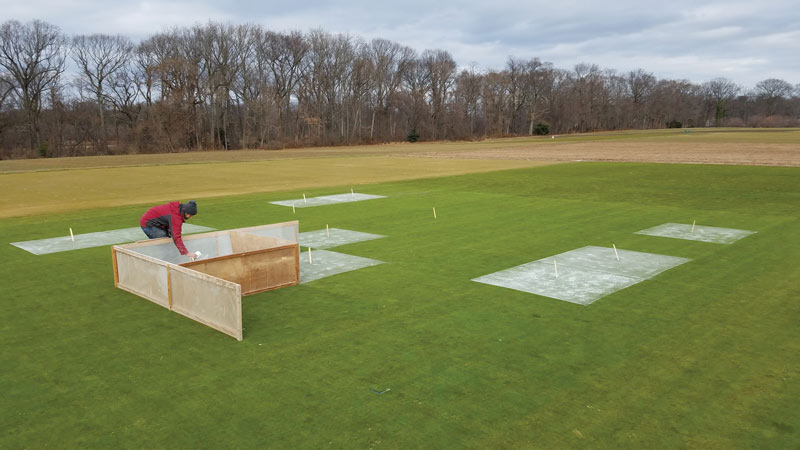
Putting greens that received liming (calcium carbonate) treatments to adjust the root-zone pH to levels between 6.0 and 6.5 had less anthracnose. Photo by James Murphy
The pH of root zones composed of silica sand and thatch can be adjusted relatively easily compared with the root zones of finer-textured or calcareous soils. Putting greens that received liming (calcium carbonate) treatments that adjusted the root zone pH between 6.0 and 6.5 had less anthracnose, but they also had higher levels of extractable soil calcium. To determine the role of calcium, if any, in suppressing anthracnose, we have been conducting experiments to determine whether a greater level of soil calcium across a range of soil pH conditions will influence anthracnose severity. Matching the soil calcium of plots across multiple soil pH levels has been challenging, but the most recent data indicates that increased soil calcium under acidic (pH = 5.6) conditions does not appear to affect anthracnose. However, this research is ongoing.
Mowing and rolling
Mowing, rolling, topdressing and irrigation are often practiced to produce a high-quality playing surface rather than to improve the agronomic health of the grass. Producing excellent playability and healthy turfgrass at the same time is a challenge, especially when anthracnose is a constant threat. Not surprisingly, anthracnose is more severe at lower cutting heights (2,29). Fortunately, other practices that improve playability (green speed) such as double-cutting and lightweight rolling (15,26) do not increase — and, in some cases, can slightly decrease — the severity of this disease (15). Similarly, additional traffic along the perimeter of putting greens associated with a change in direction of rolling equipment and cleanup mowing has not increased anthracnose (26), again showing that anthracnose is not a wound-related disease.
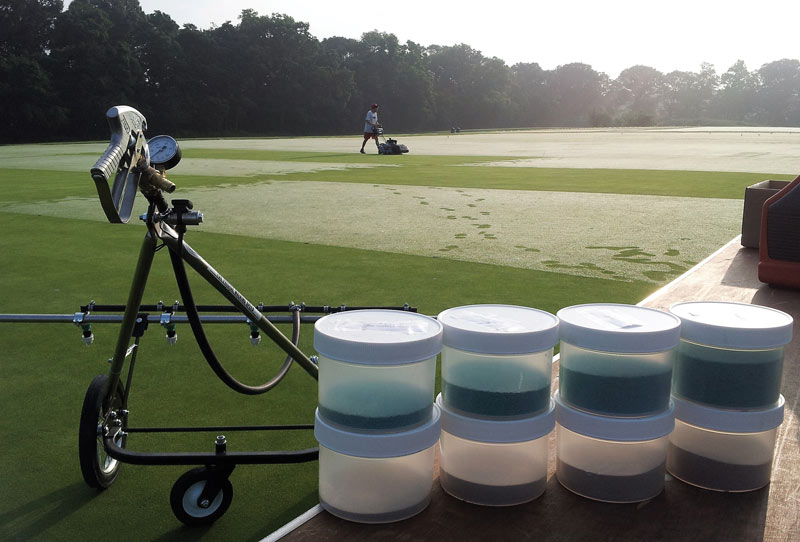
Mowing height treatments were applied before fungicide rate applications. Photo by James Hempfling
Thus, an effective approach to improving anthracnose management is to identify a combination of lightweight rolling and/or double-cutting that provides the desired playability (green speed) at the highest-feasible cutting height.
Irrigation
Both excessively wet and dry soil conditions can intensify anthracnose (24,29,30,31). Admittedly, some drying of the turf and root zone is necessary to produce firm and fast playing conditions. However, the ability to anticipate and prevent wilt stress on putting greens is key to minimizing the risk of intensifying anthracnose under a very dry irrigation program (for example, 40% ETo; 24). Thus, training staff to recognize when, where and how much light hand-watering is needed on putting surfaces is important to prevent frequent and repeated wilt stress and intensifying anthracnose during hot, dry weather.
Topdressing
Topdressing with sand throughout the growing season is a very effective practice for maintaining a firm and fast playing surface, and, fortunately, is also effective at reducing anthracnose severity. The most effective topdressing programs strive to keep the canopy full of sand and apply subsequent applications to match the growth of the turf. However, cost and interference to play can be significant challenges to implementing a routine topdressing program on putting greens. Studies over the past decade indicate that frequent topdressing (100 pounds/1,000 square feet or 0.49 kilogram/square meter every two weeks) during the playing season (summer) will greatly reduce anthracnose severity (18,19,25). Heavier topdressing during the spring is also effective at suppressing anthracnose, and is critically important if a frequent topdressing program during the summer is not practiced (11). The rate of sand topdressing needed during the spring to suppress anthracnose ranged from 400 to 800 pounds/1,000 square feet (1.95-3.90 kilograms/square meter) (11,33), which is a quantity sufficient to fill both the surface thatch and turf canopy layers. (Note that greater quantities of sand will likely be needed when coring holes are also being filled.)
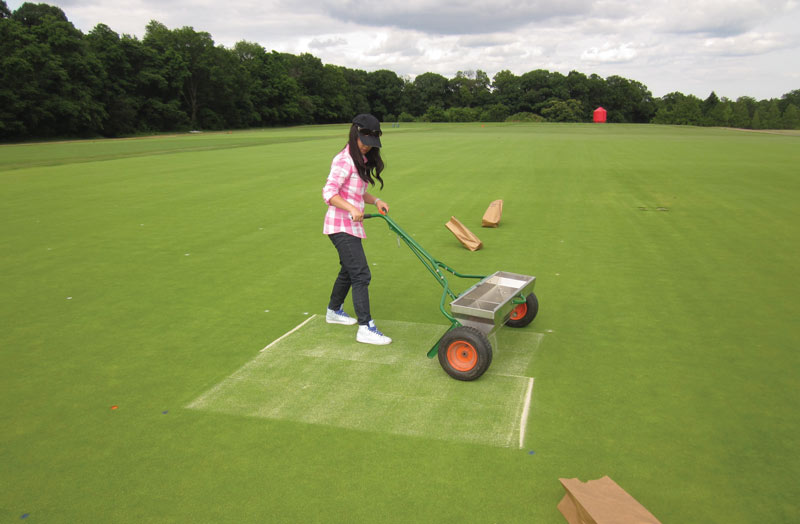
Sand topdressing treatments were applied using a drop spreader. Photo by James Hempfling
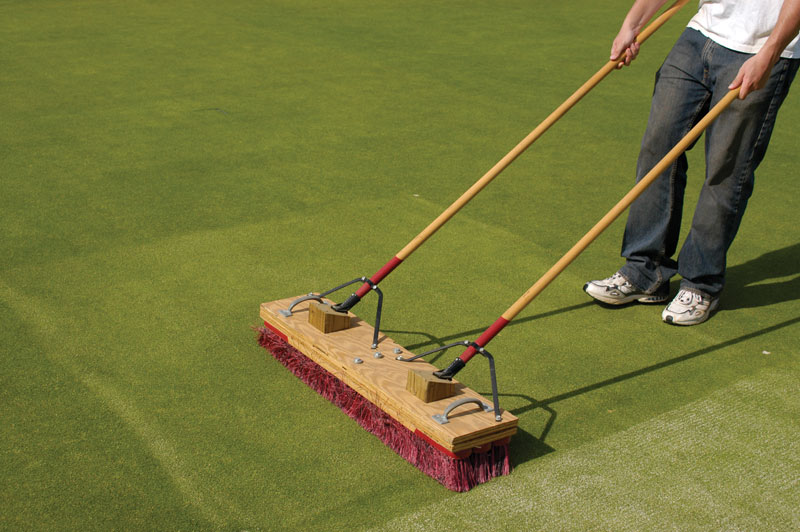
Brushing was used to incorporate sand topdressing on the research plots. Photo by James Murphy
Heavy fall topdressings are less effective than summer and spring topdressing at suppressing anthracnose; the suppressive effects of fall topdressing on anthracnose do not last beyond spring (33).
Prior to our research, initial speculation frequently suggested that sand topdressing would contribute to anthracnose epidemics on putting greens. However, topdressing has consistently reduced anthracnose in numerous research trials. Thus, any perceived increase in anthracnose associated with sand topdressing is likely due to indirect effects rather than wounding. As mentioned earlier, nutrient deficiencies and frequent drought (wilt) stress will weaken annual bluegrass and increase susceptibility to anthracnose. Thus, any increase or continuation of a routine sand topdressing program may eventually require subtle adjustments in existing fertilization and irrigation programs to compensate for the increasingly infertile and droughty mat (sand + thatch) layer that develops over time.
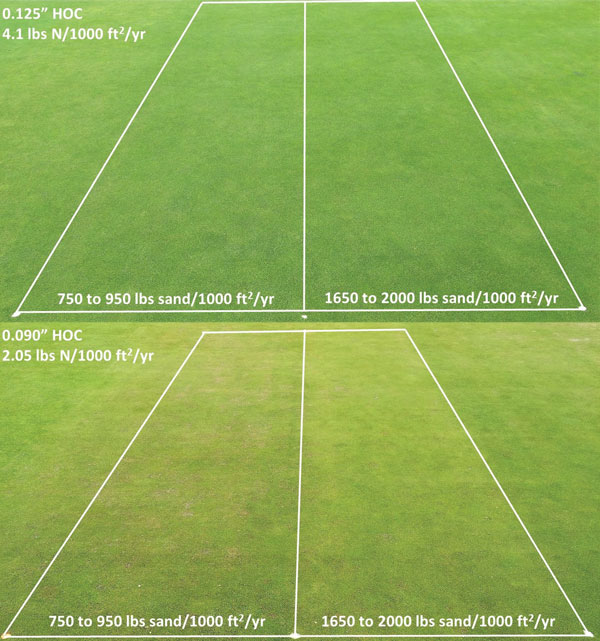
Sand topdressing had a greater impact on reducing disease and improving playability under conditions of lower mowing and lower nitrogen fertilization. HOC = height of cut. Photos by James Hempfling
Moreover, the beneficial effect of sand topdressing has been shown to hold true even under conditions of intense foot traffic (that is, the equivalent of 200 rounds per day with golf shoes fitted with soft spikes; 25). A study of sand incorporation techniques (stiff- and soft-bristled brushes, vibratory rolling, and light irrigation) and sand particle shape (round vs. sub-angular) indicated that these factors had little effect on disease severity (19). All of these findings further substantiate that wounding does not influence anthracnose on annual bluegrass turf.
Combining BMPs
Recent studies have examined the response of anthracnose to combinations of practices to gain a better understanding of their relative importance in a BMP program.
A study of nitrogen fertilization, mowing height and sand topdressing indicated that the combination of all three best practices (increased nitrogen, higher mowing and greater topdressing) was the most effective management regime for suppressing anthracnose (12). And, in two of the three years of the study with moderate epidemics, this best management regime suppressed anthracnose to levels that would be acceptable at many golf courses without the use of fungicides. However, the playability of putting surfaces managed with this best management regime may not be acceptable at some golf courses, because green speed (Stimpmeter ball roll distance) often dropped below the 9.5- to 10.5-foot range under higher mowing (0.125 inch; 3.175 mm), especially when that practice was combined with greater nitrogen fertilization.
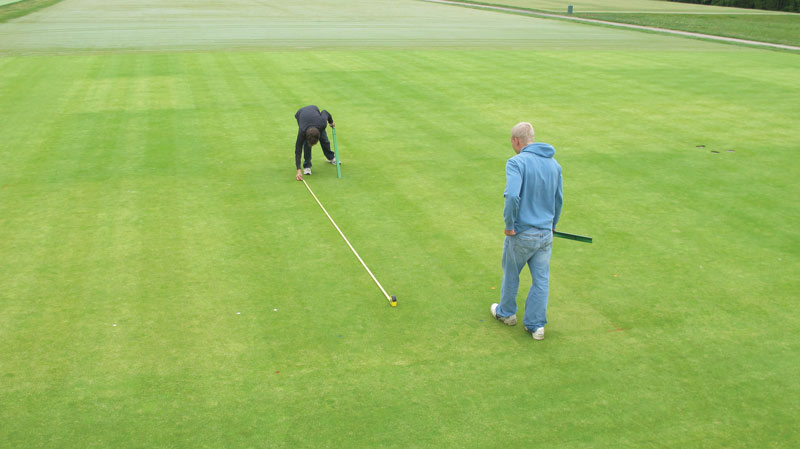
Ball roll distance measurements were taken from research plots to determine whether management regimes would affect playability of the putting surface. Photo by Youssef Elkhateeb
Research indicated that only one compromise among the three BMPs (lowering mowing height to 0.090 inch; 2.286 mm) was needed to achieve acceptable playing conditions (≥10 feet; 3 meters) 91% to 96% of the time (12). Fortunately, lowering the mowing height only presented a modest risk for increasing disease severity compared with decreasing nitrogen fertilization. It is also important to note that under lower mowing (0.090 inch), ball roll distance was much less influenced by greater nitrogen fertilization.
Although greater sand topdressing was effective in lowering disease under both nitrogen fertilization levels, the reduction in disease was more dramatic under lower nitrogen fertilization (2 pounds/1,000 square feet; 9.7 grams/square meter per year). Similarly, greater topdressing reduced disease under both mowing heights, but the reduction in disease was more substantial under the lower (0.090-inch) mowing height. Thus, golf turf managers should recognize that routine topdressing is most beneficial under lower mowing and lower nitrogen fertilization. Moreover, when adjustments in best practices for anthracnose management are needed to enhance playability (ball roll), superintendents should first consider lowering the mowing height to provide that enhancement without concern of greatly increasing the risk for anthracnose, as long as greater nitrogen and routine topdressing practices are also employed.
Fungicide efficacy
A study of the effects of mowing height and nitrogen fertility on fungicide programming for anthracnose indicated that these BMPs improve fungicide efficacy and make a reduction in fungicide inputs feasible (10). Acceptable disease control was achieved with reduced fungicide rates or fewer threshold-based applications of fungicides (extending the interval between sprays) when BMPs (greater nitrogen and higher mowing) were used. Fungicide efficacy was always best under greater nitrogen fertility, where the fungicide rate could be lowered to 25% of label rates (a 75% reduction) and still provide acceptable disease control. This study also found that threshold-based fungicide management of anthracnose was feasible; the number of fungicide applications to control anthracnose was reduced by 80% when mowing height was higher (0.125 inch) and turf was fertilized with more nitrogen (4 pounds/1,000 square feet/year).
Preventive fungicide applications have typically been considered more effective than curative applications for the control of anthracnose (1,23), and mixtures of two or more active ingredients applied as a tank-mix or prepackaged product often perform better than individual products for the control of anthracnose on annual bluegrass putting green turf (32). Moreover, combinations of different fungicide chemistries can broaden the number of diseases controlled, as well as reduce the potential for the development of fungicide resistance.
Preventive applications are often recommended at least three to four weeks before the typical onset of the disease symptoms on sites with a previous history of anthracnose. The purpose of preventive applications is to reduce the population of Colletotrichum cereale in the sward before environmental conditions conducive to anthracnose (hot, humid weather) occur. However, as stated above, early curative (threshold) sprays can result in significant reductions in fungicide inputs and excellent disease control as long as BMPs are followed. Other research has shown that fungicides should be applied in 2 gallons of water/1,000 square feet (81.49 milliliters/square meter), using nozzles that produce a medium-to-coarse droplet size to optimize control (5,23).
Currently, 12 fungicide groups (chemical classes) are labeled for the control of anthracnose on cool-season turf (see Fungicides currently available for anthracnose control). Of these groups, the demethylation inhibitors (DMI), quinone outside inhibitors (QoI or strobilurins), benzimidazoles, polyoxins and nitriles have been the most efficacious against anthracnose. Other chemical classes including the phosphonate, dicarboximide, phenylpyrrole and SDHI fungicides have been most effective when applied in a mixture with other anthracnose fungicides. Whatever fungicides are used, it is good practice to avoid the continuous use of any product to reduce the potential for fungicide resistance. For a list of current anthracnose fungicides and combination products and their efficacy against this disease, refer to Fungicides currently available for anthracnose control and Combination products currently available for anthracnose control, respectively.
Fungicide resistance management
For anthracnose, resistance has been reported for the benzimidazole and QoI fungicide groups, and reduced sensitivity (reduced interval and/or rate response) has been identified with the DMI fungicides (1,34). The Fungicide Resistance Action Committee has developed strategies to reduce the risk of resistance to fungicides.
- Use BMPs to reduce disease pressure.
- Limit the total number of fungicide applications (for example, no more than three to four SDHI applications/year) for chemical classes that have a high potential for resistance (see Table 1 and Table 2).
- Alternate fungicides with different modes of action (avoid sequential applications except for contact fungicides).
- Tank-mix fungicides that have different modes of action, and be sure that all the components of a mixture are active against the target pathogen.
- Rely on preventive applications for diseases that have previously been severe on the site and have a high risk of resistance (for example, anthracnose, dollar spot, gray leaf spot, Microdochium patch and Pythium blight).
- Avoid late-curative and reduced-rate applications that can put pressure on the pathogen to develop resistant strains, particularly for high-risk fungicide groups (for example, DMI, benzimidazole, QoI and dicarboximide fungicides).
- Reduce the interval between sprays and/or increase fungicide rates when disease pressure is high.
Following these strategies will help reduce the potential for developing fungicide-resistant strains of Colletotrichum cereale on the golf course.
Funding
This work was supported by the USDA National Institute of Food and Agriculture, Hatch Multistate Project 0206183, through the New Jersey Agricultural Experiment Station, Hatch Multistate Project NJ12294. The authors thank the Environmental Institute for Golf, GCSA of New Jersey, Tri-State Turf Research Foundation, United States Golf Association, New Jersey Turfgrass Association and Rutgers Center for Turfgrass Science for the financial support of this work.
Acknowledgments
The authors acknowledge the contributions of Joseph A. Roberts, Charles J. Schmid, James W. Hempfling, Ruying Wang and Kyle Genova.
The research says ...
- Plant nutrient deficiencies, ultra-low mowing, and excessively wet or dry irrigation programs are critical stress factors that greatly increase the risk for serious damage from anthracnose.
- Avoiding deficiencies in nitrogen and potassium is critical to reducing anthracnose severity.
- The combination of three BMPs (increased nitrogen, higher mowing and greater topdressing) was the most effective management regime for suppressing anthracnose to acceptable levels without the use of fungicides.
- Routine topdressing is most beneficial under conditions of lower mowing and lower nitrogen fertilization.
- When adjustments in BMPs for anthracnose management are needed to enhance playability (ball roll), superintendents can lower the mowing height as long as greater nitrogen and routine topdressing practices are also employed.
- Fungicide efficacy is improved and a reduction in fungicide inputs (as much as 80%) is feasible with the adoption of BMPs.
- Early-curative (threshold) sprays can result in significant reductions in fungicide inputs and excellent disease control as long as BMPs are followed.
Literature cited
- Aynardi, B., J. Inguagiato, S. McDonald, B. Clarke and W. Uddin. 2016. Lessen your anthracnose struggles. Golfdom 72 (March 11). (www.golfdom.com/lessen-your-anthracnose-struggles) Accessed Jan. 6, 2018.
- Backman, P., G. Stahnke and E. Miltner. 2002. Anthracnose update: Cultural practices affect spread of disease in Northwest. Turfgrass Trends 11:T1-T2, T4.
- Carrow, R.N., D.V. Waddington and P.E. Rieke. 2001. Turfgrass soil fertility and chemical problems. John Wiley & Sons, New York, p. 218.
- Chen, X. 2016. Influence of seasonal N fertilization, plant growth regulators, and fungicide application timing on anthracnose severity of annual bluegrass putting greens. Master’s thesis 996. University of Connecticut (http://digitalcommons.uconn.edu/gs_theses/996) Accessed Jan. 6, 2018.
- Clarke, B.B., P.R. Majumdar, S. Flatley, M. Mus, G. Rappa, G. Groben, M. Peacos, T.J. Lawson, J.B. Clark and S. Butterworth. 2015. Anthracnose control with fungicides and biorational products on annual bluegrass putting green turf, 2014. Pages 235-256. In: A.B. Gould, ed. Rutgers Turfgrass Proceedings 2014. Vol. 46. Center for Turfgrass Science and the New Jersey Turfgrass Association, New Brunswick, N.J.
- Crouch, J.A., B.B. Clarke and B.I. Hillman. 2006. Unraveling evolutionary relationships among the divergent lineages of Colletotrichum causing anthracnose disease in turfgrass and corn. Phytopathology 96:46-60.
- Danneberger, T.K., J.M. Vargas Jr. and A.L. Jones. 1984. A model for weather-based forecasting of anthracnose on annual bluegrass. Phytopathology 74:448-451.
- Dernoeden, P.H. 2002. Creeping bentgrass management: Summer stresses, weeds, and selected maladies. John Wiley & Sons, Hoboken, N.J.
- Hempfling, J.W. 2013. Anthracnose of annual bluegrass putting green turf affected by sand topdressing and cultivation. Master’s thesis. Rutgers University (https://rucore.libraries.rutgers.edu/rutgers-lib/41785/PDF/1/play) Accessed Jan. 6, 2018.
- Hempfling, J.W., B.B. Clarke and J.A. Murphy. 2014. Nitrogen fertility and mowing height effects on fungicide control of anthracnose. Page 39. In: T. Molnar and B. Fitzgerald, eds. Proceedings of the 23rd Annual Rutgers Turfgrass Symposium. Center for Turfgrass Science, Rutgers University, New Brunswick, N.J.
- Hempfling, J.W., B.B. Clarke and J.A. Murphy. 2015. Anthracnose disease on annual bluegrass as influenced by spring and summer topdressing. Crop Science 55(1):437-443.
- Hempfling, J.W., C.J. Schmid, R. Wang, B.B. Clarke and J.A. Murphy. 2017. Best management practices effects on anthracnose disease of annual bluegrass. Crop Science 57:602-610. doi:10.2135/crop sci2016.06.0492
- Inguagiato, J.C., and K. Guillard. 2016. Foliar N concentration and reflectance meters to guide N fertilization for anthracnose management of annual bluegrass putting green turf. Crop Science 56:3328-3337.
- Inguagiato, J.C., J.A. Murphy and B.B. Clarke. 2008. Anthracnose severity on annual bluegrass influenced by nitrogen fertilization, growth regulators, and verticutting. Crop Science 48:1595-1607.
- Inguagiato, J.C., J.A. Murphy and B.B. Clarke. 2009a. Anthracnose disease and annual bluegrass putting green performance affected by mowing practices and lightweight rolling. Crop Science 49:1454-1462.
- Inguagiato, J.C., J.A. Murphy and B.B. Clarke. 2009b. Anthracnose of annual bluegrass putting green turf influenced by trinexapac-ethyl application interval and rate. International Turfgrass Society Research Journal 11:207-218.
- Inguagiato, J.C., J.A. Murphy and B.B. Clarke. 2010. Anthracnose development on annual bluegrass affected by seedhead and vegetative growth regulators. Applied Turf Science doi:10.1094/ATS-2010-0923-01-RS
- Inguagiato, J.C., J.A. Murphy and B.B. Clarke. 2012. Sand topdressing rate and interval effects on anthracnose severity of an annual bluegrass putting green. Crop Science 52:1406-1415. doi:10.2135/crop sci2011.01.0010
- Inguagiato, J.C., J.A. Murphy and B.B. Clarke. 2013. Topdressing sand particle shape and incorporation effects on anthracnose severity of an annual bluegrass putting green. International Turfgrass Society Research Journal 12:127-133.
- Landschoot, P., and B. Hoyland. 1995. Shedding some light on anthracnose basal rot. Golf Course Management 11:52-55.
- Mann, R.L., and A.J. Newell. 2005. A survey to determine the incidence and severity of pests and diseases on golf course putting greens in England, Ireland, Scotland, and Wales. International Turfgrass Society Research Journal 10:224-229.
- Murphy, J., J. Inguagiato and B. Clarke. 2012. Best management practices for anthracnose on annual bluegrass: Using the correct cultural practices can lessen the severity of anthracnose disease on annual bluegrass. Golf Course Management 80(5):104-110.
- Murphy, J., F. Wong, L. Tredway, J.A. Crouch, J. Inguagiato, B. Clarke, T. Hsiang and F. Rossi. 2008. Best management practices for anthracnose on annual bluegrass turf. Golf Course Management 76(8):93-104.
- Roberts, J.A., J.C. Inguagiato, B.B. Clarke and J.A. Murphy. 2011. Irrigation quantity effects on anthracnose disease of annual bluegrass. Crop Science 51:1244-1252. doi:10.2135/cropsci2010.07.0444
- Roberts, J.A., and J.A. Murphy. 2014. Anthracnose disease on annual bluegrass as affected by foot traffic and sand topdressing. Plant Disease 98:1321-1325. doi:10.1094/PDIS-08–13–0877-RE
- Roberts, J.A., J.A. Murphy and B.B. Clarke. 2012. Lightweight rolling effects on anthracnose of annual bluegrass putting greens. Agronomy Journal 104:1176-1181. doi:10.2134/agronj2011.0269
- Schmid, C.J. 2016. Influence of nutrient management and soil pH on anthracnose severity of annual bluegrass putting green turf. Ph.D. dissertation. Rutgers University (https://rucore.libraries.rutgers.edu/rutgers-lib/51457) Accessed Jan. 6, 2018.
- Schmid, C.J., B.B. Clarke and J.A. Murphy. 2017. Anthracnose severity and annual bluegrass quality as influenced by nitrogen source. Crop Science 57:S-285-S-292. doi:10.2135/cropsci2016.06.0494
- Smiley, R.W., P.H. Dernoeden and B.B. Clarke. 2005. Compendium of turfgrass diseases. 3rd ed. APS Press, St. Paul, Minn.
- Sprague, H.B., and E.E. Evaul. 1930. Experiments with turfgrasses in New Jersey. New Jersey Agriculture Experiment Station Bulletin 497:1-55.
- Vargas, J.M., and A.J. Turgeon. 2003. Poa annua: Physiology, culture, and control of annual bluegrass. John Wiley & Sons, Hoboken, N.J.
- Vincelli, P., B.B. Clarke and G. Munshaw. 2017. Chemical control of turfgrass diseases 2017. Kentucky and Rutgers Cooperative Extension Joint Publication PPA-1.
- Wang, R. 2015. Impact of sand topdressing on turf quality, surface physical properties and disease severity of putting green turfs. Master’s thesis, Rutgers University. (https://rucore.libraries.rutgers.edu/rutgers-lib/48711/PDF/1/play) Accessed Jan. 6, 2018.
- Wong, F.P., and S. Midland. 2004. Fungicide-resistant anthracnose: bad news for greens management. Golf Course Management 72(6):75-80.
James Murphy is an Extension specialist in turfgrass management and Bruce Clarke is director of the Center for Turfgrass Science and an Extension specialist in turfgrass pathology in the Department of Plant Biology at Rutgers, The State University of New Jersey, New Brunswick, N.J. John Inguagiato is an associate professor in turfgrass pathology in the Department of Plant Science and Landscape Architecture at the University of Connecticut, Storrs.